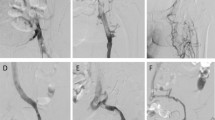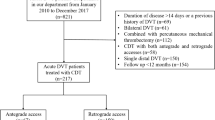Abstract
Purpose
Retrospective evaluation of local low-dose thrombolysis for treatment of venous port-catheter thrombosis.
Methods
A total of 1,031 patients with dysfunctional port systems underwent port angiography depicting 181 patients with thrombosis around the port-catheter. A total of 165 patients (male 35, female 130; age 57.3 ± 12.9 [20–83] years) underwent thrombolysis by single injection of 3 mg alteplase into the port system. Patients were followed up by clinical and angiographic/radiological port controls the next day and 12.9 ± 17.9 [1–81] months on the basis of regular oncologic staging examinations.
Results
Thrombosis occurred 10.1 ± 19.3 [median 2.9] months after port implantation and was clinically suspected by difficult blood aspiration in 146 of 181 (80.7 %) and high resistance to injection fluids in 75 (41.4 %) patients. A predictor for angiographically confirmed port-catheter thrombosis was a combination of both (73, 40.3 % patients) (Fisher’s exact test p < 0.0001; positive predictive value 0.8977), or suboptimal (not cavoatrial) port-catheter position (92, 50.8 % patients) (p = 0.0047; positive predictive value 0.8276). The cumulative success rate of thrombolysis was 92.7 % (153 of 165 patients). Initial thrombolysis was effective in 127 (77.0 %) patients. Repeated (up to 6 times) thrombolysis was effective in 26 of 31 patients after second or third thrombolysis. Extensive central venous thrombosis (9 patients) predicted ineffective thrombolysis (p < 0.0001). Primary patency of successfully treated devices was 92.8 % at 1 month and 84.9 % at 3 months. Rethrombosis occurred in 27 patients after 4.4 ± 6.6 (median 1.8) months. Primary rethrombolysis was effective in 22 (81.5 %) patients. Cumulative patency was 100 % at 3 months.
Conclusions
Difficult aspiration combined with high resistance to injection fluids or suboptimal port-catheter position are strong independent predictors for port-catheter thrombosis. Local low-dose thrombolysis or repeat thrombolysis is safe and effective in the absence of large central venous thrombosis.


Similar content being viewed by others
References
Kock HJ, Pietsch M, Krause U, Wilke H, Eigler FW. Implantable vascular access systems: experience in 1500 patients with totally implanted central venous port systems. World J Surg. 1998;22:12–6.
Stein M, Wagner RH. [Complications of central venous access devices: outcome analysis of 2359 implantations]. Dtsch Med Wochenschr. 2005;130:1129–32.
Vardy J, Engelhardt K, Cox K, Jacquet J, McDade A, Boyer M, et al. Long-term outcome of radiological-guided insertion of implanted central venous access port devices (CVAPD) for the delivery of chemotherapy in cancer patients: institutional experience and review of the literature. Br J Cancer. 2004;91:1045–9.
Moureau N, Poole S, Murdock MA, Gray SM, Semba CP. Central venous catheters in home infusion care: outcomes analysis in 50,470 patients. J Vasc Interv Radiol. 2002;13:1009–16.
Wieners G, Redlich U, Dudeck O, Schütte K, Ricke J, Pech M. [First experiences with intravenous port systems authorized for high pressure injection of contrast agent in multiphasic computed tomography]. Rofo. 2009;181:664–8.
Lenhart M, Schätzler S, Manke C, Strotzer M, Seitz J, Gmeinwieser J, et al. [Radiological placement of peripheral central venous access ports at the forearm. Technical results and long term outcome in 391 patients]. Rofo. 2010;182:20–8.
Daeihagh P, Jordan J, Chen J, Rocco M. Efficacy of tissue plasminogen activator administration on patency of hemodialysis access catheters. Am J Kidney Dis. 2000;36:75–9.
Gabrail N, Sandler E, Charu V, Anas N, Lim E, Blaney M, et al. TROPICS 1: a phase III, randomized, double-blind, placebo-controlled study of tenecteplase for restoration of function in dysfunctional central venous catheters. J Vasc Interv Radiol. 2010;21:1852–8.
Glaser DW, Medeiros D, Rollins N, Buchanan GR. Catheter-related thrombosis in children with cancer. J Pediatr. 2001;138:255–9.
Gray RJ, Levitin A, Buck D, Brown LC, Sparling YH, Jablonski KA, et al. Percutaneous fibrin sheath stripping versus transcatheter urokinase infusion for malfunctioning well-positioned tunneled central venous dialysis catheters: a prospective, randomized trial. J Vasc Interv Radiol. 2000;11:1121–9.
Semba CP, Deitcher SR, Li X, Resnansky L, Tu T, McCluskey ER. Treatment of occluded central venous catheters with alteplase: results in 1,064 patients. J Vasc Interv Radiol. 2002;13:1199–205.
Tumlin J, Goldman J, Spiegel DM, Roer D, Ntoso KA, Blaney M, et al. A phase III, randomized, double-blind, placebo-controlled study of tenecteplase for improvement of hemodialysis catheter function: TROPICS 3. Clin J Am Soc Nephrol. 2010;5:631–6.
Whigham CJ, Lindsey JI, Goodman CJ, Fisher RG. Venous port salvage utilizing low dose tPA. Cardiovasc Interv Radiol. 2002;25:513–6.
Zajko AB, Reilly JJ Jr, Bron KM, Desai R, Steed DL. Low-dose streptokinase for occluded Hickman catheters. AJR Am J Roentgenol. 1983;141:1311–2.
Crain MR, Mewissen MW, Ostrowski GJ, Paz-Fumagalli R, Beres RA, Wertz RA. Fibrin sleeve stripping for salvage of failing hemodialysis catheters: technique and initial results. Radiology. 1996;198:41–4.
Johnstone RD, Stewart GA, Akoh JA, Fleet M, Akyol M, Moss JG. Percutaneous fibrin sleeve stripping of failing haemodialysis catheters. Nephrol Dial Transplant. 1999;14:688–91.
Knelson MH, Hudson ER, Suhocki PV, Payne CS, Sallee DS, Newman GE. Functional restoration of occluded central venous catheters: new interventional techniques. J Vasc Interv Radiol. 1995;6:623–7.
Merport M, Murphy TP, Egglin TK, Dubel GJ. Fibrin sheath stripping versus catheter exchange for the treatment of failed tunneled hemodialysis catheters: randomized clinical trial. J Vasc Interv Radiol. 2000;11:1115–20.
Rockall AG, Harris A, Wetton CW, Taube D, Gedroyc W, Al-Kutoubi MA. Stripping of failing haemodialysis catheters using the Ampltaz gooseneck snare. Clin Radiol. 1997;52:616–20.
Silberzweig JE, Sacks D, Khorsandi AS, Bakal CW. Reporting standards for central venous access. Technology Assessment Committee. J Vasc Interv Radiol. 2000;11:391–400.
Biffi R, Orsi F, Pozzi S, Pace U, Bonomo G, Monfardini L, et al. Best choice of central venous insertion site for the prevention of catheter-related complications in adult patients who need cancer therapy: a randomized trial. Ann Oncol. 2009;20:935–40.
Biffi R, De Braud F, Orsi F, Pozzi S, Arnaldi P, Goldhirsch A, et al. A randomized, prospective trial of central venous ports connected to standard open-ended or Groshong catheters in adult oncology patients. Cancer. 2001;92:1204–12.
Caers J, Fontaine C, Vinh-Hung V, De Mey J, Ponnet G, Oost C, et al. Catheter tip position as a risk factor for thrombosis associated with the use of subcutaneous infusion ports. Support Care Cancer. 2005;13:325–31.
Puel V, Caudry M, Le Métayer P, Baste JC, Midy D, Marsault C, et al. Superior vena cava thrombosis related to catheter malposition in cancer chemotherapy given through implanted ports. Cancer. 1993;72:2248–52.
Wun T, White RH. Venous thromboembolism (VTE) in patients with cancer: epidemiology and risk factors. Cancer Invest. 2009;27(Suppl 1):63–74.
Kakkar AK, Levine M, Pinedo HM, Wolff R, Wong J. Venous thrombosis in cancer patients: insights from the FRONTLINE survey. Oncologist. 2003;8:381–8.
Levitan N, Dowlati A, Remick SC, Tahsildar HI, Sivinski LD, Beyth R, et al. Rates of initial and recurrent thromboembolic disease among patients with malignancy versus those without malignancy. Risk analysis using Medicare claims data. Medicine (Baltimore). 1999;78:285–91.
Falanga A, Zacharski L. Deep vein thrombosis in cancer: the scale of the problem and approaches to management. Ann Oncol. 2005;16:696–701.
Blom JW, Doggen CJM, Osanto S, Rosendaal FR. Malignancies, prothrombotic mutations, and the risk of venous thrombosis. JAMA. 2005 9;293:715–22.
Haddad TC, Greeno EW. Chemotherapy-induced thrombosis. Thromb Res. 2006;118:555–68.
Gomes MPV, Deitcher SR. Diagnosis of venous thromboembolic disease in cancer patients. Oncology. 2003;17:126–135, 139.
Salwender HJ, Egerer G, Bach A, Hahn U, Goldschmidt H, Ho AD. Central venous catheter–related complications. Antibiot Chemother. 2000;50:133–43.
Tschirhart JM, Rao MK. Mechanism and management of persistent withdrawal occlusion. Am Surg. 1988;54:326–8.
Whigham CJ, Greenbaum MC, Fisher RG, Goodman CJ, Thornby JI, Thomas JW. Incidence and management of catheter occlusion in implantable arm ports: results in 391 patients. J Vasc Interv Radiol. 1999;10:767–74.
Disclosure
None.
Author information
Authors and Affiliations
Corresponding author
Rights and permissions
About this article
Cite this article
Massmann, A., Jagoda, P., Kranzhoefer, N. et al. Local Low-Dose Thrombolysis for Safe and Effective Treatment of Venous Port-Catheter Thrombosis. Ann Surg Oncol 22, 1593–1597 (2015). https://doi.org/10.1245/s10434-014-4129-0
Received:
Published:
Issue Date:
DOI: https://doi.org/10.1245/s10434-014-4129-0




